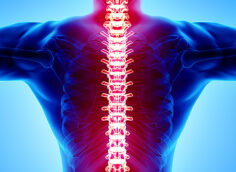No Such Thing As Off Days
If you have serious training goals, there's no such thing as off days. Well, not "off-off" days at least. Instead of just sitting around on rest days, use active recovery techniques to speed up the regeneration process. Here are four methods that work.
Most of the time, we use SMR techniques acutely, treating trigger points in soft tissues with small, targeted movements, often before training. But this is different. To turn an off day into an accelerated recovery day, we're going to hit some of the biggest muscles in the body using the "pizza dough roller" effect.
By using larger passes from 4-12 inches at a time, you'll be able to cover more area and eventually the complete region. Prioritizing the largest tissues in the body will give you the best bang for your systemic recovery buck. The five key areas to include are the quads, glutes, hams, pecs, and lats. Forget about majoring in the minor tissues, stick with the big boys here.
Since the goal here is recovery, you must spend some serious time on each of these tissues. The big five mentioned above are the largest, broadest, and thickest muscles in the body, so we need more than a half-assed 30 seconds to fully cover the surface area these heavy hitters.
Spend at least 2-3 minutes on each muscle group, coursing from the most distal aspect of the muscle to the most proximal. There's no way to overdo this aspect of recovery. Just make sure the rest of your body remains in a relaxed state and that you're using deep breathing techniques.
By using both active dynamic oscillatory stretching with active static stretching, you speed up the recovery process by increasing lymphatic drainage and the clearance of byproducts and wastes from contractile tissue.
Here's how it works:
- Choose a position that lets you get an end-range stretch of the targeted tissue.
- Start by oscillating in and out of end range for 30-60 seconds. These are small back and forth motions to extend the neural tone and resistance of the tissues being stretched to achieve a more extended end range.
- Without taking the stretch off after the oscillation period has ended, you'll hold an end-range static stretch for 60-120 seconds.
This technique can be used for all muscle groups, but it works best with the anterior chain musculatures that are susceptible to chronic tightness such as the pecs and hip flexors.
The last thing you want to do on an off day is mentally check out and unconsciously go through your corrective exercises and mobility drills from the last week's programming. To make sure this doesn't happen, I've learned to program larger "catch-all" movements.
These are exercises that target multiple areas of the body in one sequence, placing an emphasis on full-body motor control recruitment as opposed to a more specific or targeted drill such as glute or lat activation.
The art and functionality of the flow-based movement session fits perfectly into my idea of prioritizing what's important for active recovery days. Not only are we hard-wiring functional movement capacity, we're elevating the heart rate and stimulating the active muscle pump of the body to aid in recovery.
Choose 3-4 catch-all movements and cycle through them a few times, using 8-10 reps per side to target your weakest functional areas.
Keep these fresh. Catch-all movements were meant to stimulate neural learning in new positions and stabilization patterns. Novelty is king when re-educating your movement patterns, so keep that in mind when you want to mentally check out of your next training session.
Many athletes and lifters scoff at the idea of doing any form of steady state cardio, let alone the lowest level activities such as walking and biking. It's true that cardio isn't sexy, but from a regeneration and recovery perspective, low-level cardio can minimize joint stress, thus improving daily activity levels on a day away from the gym while still tapping into your cardio-respiratory system to aid in central systemic-based recovery.
By replacing an off day with an active recovery day, we're able to burn more calories with very low central nervous system or mechanical fatigue to the body. That said, use of intra-workout nutrition ensures this active recovery method doesn't put you in the caloric hole for the day, and maybe even the week.
This is especially important if you choose to extend the aerobic based energy systems training for more than 30-45 minutes. The last thing we want to do during an active recovery day is to cause fatigue. Proper nutrition and using variations in your aerobic work will keep this from happening.
Shoot for a heart rate of 100-125 beats per minute through walking, hiking, biking, and even the dreaded elliptical. The goal here is to keep joint stress to a minimum, burn a few calories, fuel up, and prepare for the workout ahead.
Turn your switch down to low and realize that the more strategic you are on your recovery days, the better you can let it rip in your training.




